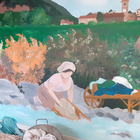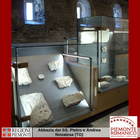Statio ad Fines
Avigliana
![]()
The portion of area placed beyond the river Dora Riparia, where the rural villages of Drubiaglio and Malano expand, represents the most important archaelogical area in Avigliana. In this area, on the left bank of the river, near the ancient Roman road, there was the “statio ad fines”, the frontier crossing between the “Regio XI” of Augustan Italy and the prefecture of the Celtic king Cozio. This frontier crossing operated also as a collection customs office of the “Quadragesima Galliarum”, the tax on the goods in transit between Italy and Gaul. This was the most important town from a functional point of view of the piedmont area west of Augusta Taurinorum. Even if nowadays we can’t see anything on the surface, in the second half of the XIXth century the Capuchin Placido Bacco worked there in seclusion digging the wide pit of the temple of the Matron Goddesses. He brought to light some of the most significant sculptural and epigraphic finds of the Piedmontese Roman world: from the cippus of Acestes, where the Matrons dance with their arms linked in a chain, to the bas-relief of the prisoner, from potteries to coloured glasses, handles, fibulas and bronze studs.
Informazioni e orari
Investigations
Suggestions
| Almese | Roman Villa |
| Avigliana | Castle |
| Avigliana | Chiesa e Priorato di San Bartolomeo al Lago Piccolo di Avigliana |
| Avigliana | Avigliana |
| Avigliana | Museo etnografico Il Vomere |
| Borgone Susa | Maometto |
| Caselette | Villa Rustica |
| Novalesa | Novalesa Archaelogical Museum |
| Susa | Archaelogical areas |
| Susa | Castle of Susa - Civic Museum |
View as a list
Services
- Associazione Archeologica Aviglianese - Avigliana
- B&B Corte del Forno - Avigliana
- The Butterfly Garden B&B - Avigliana
- Convent of San Francesco - Holiday home - Avigliana
- Convent of San Francesco - Restaurant - Avigliana
- Caprice hotel - Avigliana
- The Brewery - Avigliana
- San Michele restaurant - Avigliana
- Tourist Office of Avigliana - Avigliana
- B&B Castle of Camerletto - Caselette










